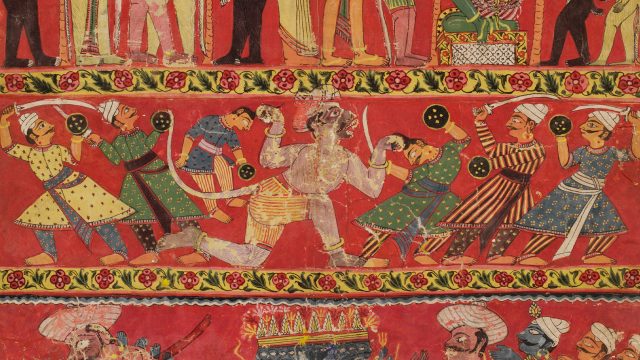A masterpiece of late gothic painting presides in solitary splendour over one end of the Raphael Cartoon Courts, isolated from its medieval and early renaissance counterparts on the other side of the Museum: the St George altarpiece from Valencia. It is not only one of the V&A’s most important late medieval treasures, it is also one of the finest Spanish gothic altarpieces to survive, and the only example of its kind in Britain.

Master of the Centenar (Attributed to, production) and Marçal de Sas, Andrés (Formerly ascribed to, production), Alterpiece of St George, Valencia, Spain, Tempera and Gilt on Pine Panel, Raphael Gallery, Room 48a, Mus Ref: 2006AF9838 © Victoria and Albert Museum, London
The altarpiece was commissioned by the Centenar de la Ploma, the confraternity of crossbowmen of Valencia, a prestigious civic militia company, for its chapel or assembly room. It has been attributed on stylistic grounds to a German painter documented in early fifteenth-century Valencia, Marzal de Sas (Saxony), although his authorship is not certain. Measuring 6.6 metres high and 5.5 metres wide, its vast scale and multi-panelled format are typical of Spanish altarpieces from the medieval and renaissance periods, which typically occupied the entire wall above the altar itself and were edged with a sloping frame known as a guardapolvos (dust guard) that, as the name suggests, served a practical and protective function. The guardapolvos of the St George altarpiece is decorated with the Centenar’s insignia of the crossbow and the cross of St George, its patron saint.

Master of the Centenar (Attributed to, production) and Marçal de Sas, Andrés (Formerly ascribed to, production), Alterpiece of St George, Valencia, Spain, Tempera and Gilt on Pine Panel, Raphael Gallery, Room 48a, Mus Ref: 2006AF9838 © Victoria and Albert Museum, London
Although the patron saint of England, St George is far from being an exclusively English saint. He was a legendary warrior saint whose cult originated in the eastern Church and spread to western Europe via the Crusades; as an emblem of Christian triumph he was particularly popular in Spain during the era of the reconquest of the peninsula from its Islamic rulers. Indeed one of the three principal panels of the altarpiece, which run vertically through its centre, depicts the Battle of El Puig (1237), a turning point in the reconquest, when St George was believed to have come miraculously to the aid of the Christian army, led by King James I of Aragon – seen here in striped red and gold livery, with St George at his side.

© Victoria and Albert Museum, London
The panel immediately below shows the scene of St George fighting the dragon – symbolic of Christ’s victory over Satan –paralleling the episode above, in which the king strikes at his enemies.

© Victoria and Albert Museum, London
The militantly Christian message of the altarpiece, which may jar with modern audiences, needs to be understood in the historical and religious context of its time. Above the battle scene, the Virgin and Child are enthroned, and atop them, in a smaller panel, is Christ as Saviour of the World, denoted by the orb he holds; small figures of saints and prophets adorning the pilasters and gables of the altarpiece and Passion scenes on the predella reinforce the message of salvation through Christ’s Church.

© Victoria and Albert Museum, London
On either side of the main triad of panels are narrative scenes depicting the legend of St George, beginning with the moment when the Virgin and angels arm him as a Knight of Christ, and continuing with his salvation of the city of Silene in Syria, where he rescues the princess from the dragon and brings about the conversion of its citizens to Christianity. It ends with his eventual martyrdom under the Roman Emperor Diocletian after a series of particularly gruesome failed attempts: he dies by beheading, but not until he has undergone boiling in oil, sawing in half, crucifixion and a number of other torments. (You can view all these scenes in detail on the V&A’s Search the Collections website).

© Victoria and Albert Museum, London

© Victoria and Albert Museum, London
Whatever we may think about its imagery and meaning, the St George altarpiece cannot fail to impress on account of its size and sheer opulence – its vivid colours and resplendent carved, gilded and silvered surfaces (the latter now tarnished) make it a beacon in the otherwise cool-toned Raphael cartoon court, reminding us of the brilliant visual effect it must have commanded in its original setting. Often invoked as an example of the so-called ‘International Gothic’ style prevalent in Europe around 1400, the St George altarpiece combines elements derived from Italy and northern Europe, a reminder that as one of the principal trading centres of the Mediterranean, Valencia offered rich opportunities for cultural and artistic exchange.
Twenty Objects for Twenty Years are a series of short pieces written by Paula Nuttall to celebrate the twentieth anniversary of our Late Medieval to Early Renaissance year course. To see previous articles take a look at the Learning Team’s blog or have a look at the previous one in the series, Maiolica Dish, 1485 – 1490.



Very well written, Paula. Just a correction, if I may. The battle of El Puig took place in Valencia, which is not Catalonia. Valencia was a kingdom (James I being the first king) and Catalonia never had a king other than that from Aragon.